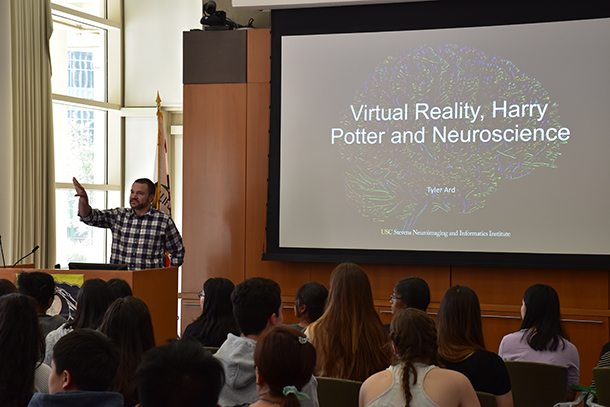Most high schools don’t offer neuroscience classes, but Los Angeles area high school students can still learn about the brain. On Feb. 3, local teens converged on USC’s Health Sciences Campus for the Los Angeles Brain Bee, a day of exploration, networking and competition. The event, sponsored by the Society for Neuroscience and coordinated by the Zilkha Neurogenetic Institute (ZNI), the USC Mark and Mary Stevens Neuroimaging and Informatics Institute and UCLA’s Brain Research Institute, provided 60 aspiring neuroscientists with an opportunity to learn more about careers in the field and opportunities within higher education.
“The Brain Bee aims to interest high schoolers in the complexities of the brain, exploring multiple aspects of this complicated organ, which influences everything we do,” said Berislav Zlokovic, MD, PhD, chair and professor of physiology and neuroscience at the Keck School of Medicine of USC, Mary Hayley and Selim Zilkha Chair in Alzheimer’s Disease Research and director of ZNI. “Many of the participants go on to study neuroscience and choose careers in teaching or industry.”
In partnership with the student-run InterAxon group from UCLA, USC volunteers from labs across both campuses organized and ran the event. The University of California, Irvine, and Los Angeles Community College provided additional support.
“This was the tenth year that we’ve co-organized this event with UCLA and we’re happy to bring on new partners each year from across the Southland. With all of the hands-on activities, the kids learn a lot and meet experts in the field, while sharing a fun day with their families,” said David Warren, ZNI’s director of operations, who primarily credits his colleague Amy Nelson, PhD, postdoctoral scholar – research associate at the Keck School, for helping orchestrate this year’s event.
Challenge begins
The 2018 Brain Bee began with a written examination and an anatomy practicum, which tested students’ knowledge of anatomical structures, brain functions and dysfunctions, research techniques and medical technology. Next, competitors and their parents had the opportunity to attend a panel discussion with neuroscience faculty, graduate and undergraduate students to learn more about education and career options.
To kick off the afternoon activities, students rotated through stations where they performed sheep brain and eye dissections, observed MRI in action and explored brain computer interfaces, to name a few.
Dominique Duncan, PhD and Tyler Ard, PhD, both assistant professors at the Keck School, gave presentations highlighting novel uses of cinematography and virtual reality (VR) in neuroscience. Duncan spoke about her use of VR to streamline neuroimaging analyses, as well as her research on epilepsy and seizures; she currently supports the USC Stevens Neuroimaging and Informatics Institute in a multicenter study aimed at developing a treatment, cure or prevention strategy for post-traumatic epilepsy.
Using a clip from the Harry Potter series, Ard discussed how a graphical technique called particle rendering — originally developed for the cinema industry — has been repurposed by neuroscientists to visualize MRI data using millions of tiny dots. The technique can help researchers better map connections in the brain and detect subtle abnormalities in blood flow.
Qualifying for nationals
The event concluded with the final stage of the competition: three fast-paced rounds of jeopardy for the 10 students who scored highest on the written and practical tests. Students selected from categories such as “Stress and Aging” and “Memory Molecules” and adeptly answered questions like “What is the metal ion that blocks the pore of the NMDA receptor?” (The answer is magnesium.)
The grand prize winner, Anish Natarajan, will receive an all-expenses-paid trip to Baltimore to participate in the National Brain Bee in March. A junior at Oak Park High School in Thousand Oaks, Natarajan said the brain has always fascinated him, “both because it’s the body’s control center and because of its philosophical ramifications,” for instance in terms of consciousness. After high school, he hopes to enter the neurology program at USC or UCLA and ultimately pursue a career in research.
“One of INI’s top priorities is to empower and train students of all ages, giving them the tools they need to pursue productive careers in neuroscience,” said Arthur W. Toga, PhD, Provost Professor of Ophthalmology, Neurology, Psychiatry and the Behavioral Sciences, Radiology and Engineering, Ghada Irani Chair in Neuroscience and director of the USC Stevens Institute for Neuroimaging and Informatics. “It was a pleasure to welcome such talented and driven competitors to the Brain Bee this year, and we look forward to continuing and expanding our outreach efforts in years to come.”
— Zara Abrams


